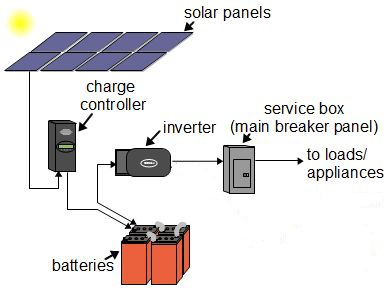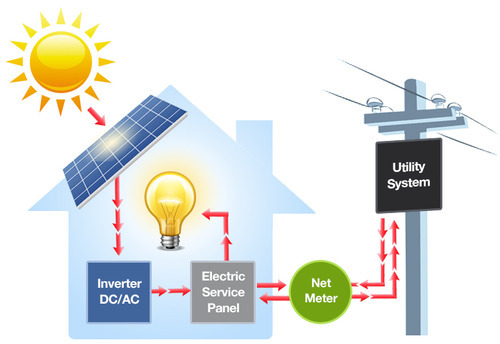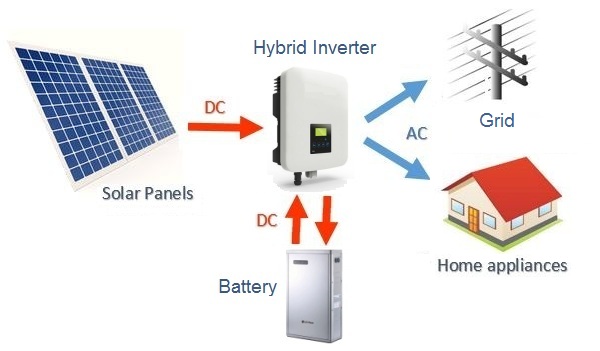Stand Alone Systems
A stand-alone power system (SAPS or SPS), also known as remote area power supply (RAPS), is an off-the-grid electricity system for locations that are not fitted with an electricity distribution system. Typical SAPS include one or more methods of electricity generation, energy storage, and regulation.
Electricity is typically generated by one or more of the following methods:
Photovoltaic system using solar panels
Wind turbine
Geothermal source
Micro combined heat and power
Micro hydro
Diesel or biofuel generator
Thermoelectric generator (TEGs)
Storage is typically implemented as a battery bank, but other solutions exist including fuel cells. Power drawn directly from the battery will be direct current extra low voltage (DC ELV), and this is used especially for lighting as well as for DC appliances. An inverter is used to generate AC low voltage, which more typical appliances can be used with. A typical stand-alone solar PV system at a sewage treatment plant in Santuari de Lluc, Spain Stand-alone photovoltaic power systems are independent of the utility grid and may use solar panels only or may be used in conjunction with a diesel generator, a wind turbine or batteries.
Electricity is typically generated by one or more of the following methods:
Photovoltaic system using solar panels
Wind turbine
Geothermal source
Micro combined heat and power
Micro hydro
Diesel or biofuel generator
Thermoelectric generator (TEGs)
Storage is typically implemented as a battery bank, but other solutions exist including fuel cells. Power drawn directly from the battery will be direct current extra low voltage (DC ELV), and this is used especially for lighting as well as for DC appliances. An inverter is used to generate AC low voltage, which more typical appliances can be used with. A typical stand-alone solar PV system at a sewage treatment plant in Santuari de Lluc, Spain Stand-alone photovoltaic power systems are independent of the utility grid and may use solar panels only or may be used in conjunction with a diesel generator, a wind turbine or batteries.
-
CALL US FOR MORE INFORMATION (787)597-4994
Grid Tie Systems
A grid-tied electrical system, also called tied to grid or grid tie system, is a semi-autonomous electrical generation or grid energy storage system which links to the mains to feed excess capacity back to the local mains electrical grid. When insufficient electricity is available, electricity drawn from the mains grid can make up the shortfall. Conversely when excess electricity is available, it is sent to the mains grid. When batteries are used for storage, the system is called battery-to-grid (B2G), which includes vehicle-to-grid (V2G).
Direct Current (DC) electricity from sources such as hydro, wind or solar is passed to an inverter which is grid tied. The inverter monitors the alternating current mains supply frequency and generates electricity that is phase matched to the mains. When the grid fails to accept power during a "black out", most inverters can continue to provide courtesy power.
-
CALL US FOR MORE INFORMATION (787)597-4994
Hybrid Systems
A solar hybrid power systems are hybrid power systems that combine solar power from a photovoltaic system with another power generating energy source. A common type is a photovoltaic diesel hybrid system, combining photovoltaics (PV) and diesel generators, or diesel gensets, as PV has hardly any marginal cost and is treated with priority on the grid. The diesel gensets are used to constantly fill in the gap between the present load and the actual generated power by the PV system.
As solar energy is fluctuating, and the generation capacity of the diesel genesets is limited to a certain range, it is often a viable option to include battery storage in order to optimize solar's contribution to the overall generation of the hybrid system.
Other solar hybrids include solar-wind systems. The combination of wind and solar has the advantage that the two sources complement each other because the peak operating times for each system occur at different times of the day and year. The power generation of such a hybrid system is more constant and fluctuates less than each of the two component subsystems.
Other solar hybrids include solar-wind systems. The combination of wind and solar has the advantage that the two sources complement each other because the peak operating times for each system occur at different times of the day and year. The power generation of such a hybrid system is more constant and fluctuates less than each of the two component subsystems.
-
CALL US FOR MORE INFORMATION (787)597-4994


